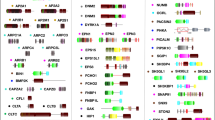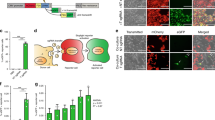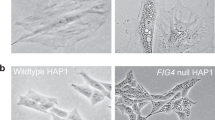Abstract
Clathrin-mediated endocytosis is essential for a wide range of cellular functions. We used a multi-step siRNA-based screening strategy to identify regulators of the first step in clathrin-mediated endocytosis, formation of clathrin-coated vesicles (CCVs) at the plasma membrane. A primary genome-wide screen identified 334 hits that caused accumulation of CCV cargo on the cell surface. A secondary screen identified 92 hits that inhibited cargo uptake and/or altered the morphology of clathrin-coated structures. The hits include components of four functional complexes: coat proteins, V-ATPase subunits, spliceosome-associated proteins and acetyltransferase subunits. Electron microscopy revealed that V-ATPase depletion caused the cell to form aberrant non-constricted clathrin-coated structures at the plasma membrane. The V-ATPase-knockdown phenotype was rescued by addition of exogenous cholesterol, indicating that the knockdown blocks clathrin-mediated endocytosis by preventing cholesterol from recycling from endosomes back to the plasma membrane.
This is a preview of subscription content, access via your institution
Access options
Subscribe to this journal
Receive 12 print issues and online access
$209.00 per year
only $17.42 per issue
Buy this article
- Purchase on Springer Link
- Instant access to full article PDF
Prices may be subject to local taxes which are calculated during checkout








Similar content being viewed by others
Accession codes
References
Pelkmans, L. et al. Genome-wide analysis of human kinases in clathrin- and caveolae/raft-mediated endocytosis. Nature 436, 78–86 (2005).
Snijder, B. et al. Population context determines cell-to-cell variability in endocytosis and virus infection. Nature 461, 520–523 (2009).
Collinet, C. et al. Systems survey of endocytosis by multiparametric image analysis. Nature 464, 243–249 (2010).
Balklava, Z., Pant, S., Fares, H. & Grant, B.D. Genome-wide analysis identifies a general requirement for polarity proteins in endocytic traffic. Nat. Cell Biol. 9, 1066–1073 (2007).
Kozik, P., Francis, R. W., Seaman, M. N. & Robinson, M. S. A screen for endocytic motifs. Traffic 11, 843–855 (2010).
Donaldson, J. G. & Williams, D. B. Intracellular assembly and trafficking of MHC class I molecules. Traffic 10, 1745–1752 (2009).
Zhang, X. D. Novel analytic criteria and effective plate designs for quality control in genome-scale RNAi screens. J. Biomol. Screen. 13, 363–377 (2008).
Keyel, P. A. et al. A single common portal for clathrin-mediated endocytosis of distinct cargo governed by cargo-selective adaptors. Mol. Biol. Cell 17, 4300–4317 (2006).
Jackson, A. et al. Position-specific chemical modification of siRNAs reduces ‘off-target’ transcript silencing. RNA 12, 1197–1205 (2006).
Birmingham, A. et al. 3’ UTR seed matches, but not overall identity, are associated with RNAi off-targets. Nat. Methods 3, 199–204 (2006).
Tebar, F., Bohlander, S. K. & Sorkin, A. Clathrin assembly lymphoid myeloid leukemia (CALM) protein: localization in endocytic-coated pits, interactions with clathrin, and the impact of overexpression on clathrin-mediated traffic. Mol. Biol. Cell 10, 2687–2702 (1999).
Hinrichsen, L., Harborth, J., Andrees, L., Weber, K. & Ungewickell, E. J. Effect of clathrin heavy chain- and α-adaptin-specific small inhibitory RNAs on endocytic accessory proteins and receptor trafficking in HeLa cells. J. Biol. Chem. 278, 45160–45170 (2003).
Von Mering, C. et al. STRING: known and predicted protein-protein associations,integrated and transferred across organisms. Nucl. Acids Res. 33, D433–D437 (2005).
Johnson, L. S., Dunn, K. W., Pytowski, B. & McGraw, T. E. Endosome acidification and receptor trafficking: bafilomycin A1 slows receptor externalization by a mechanism involving the receptor’s internalization motif. Mol. Biol. Cell 4, 1251–1266 (1993).
Brown, D., Paunescu, T. G., Breton, S. & Marshansky, V. Regulation of the V-ATPase in kidney epithelial cells: dual role in acid-base homeostasis and vesicle trafficking. J. Exp. Biol. 212, 1762–1772 (2009).
Heuser, J. Effects of cytoplasmic acidification on clathrin lattice morphology. J. Cell. Biol. 108, 401–411 (1989).
Heuser, J. E. & Anderson, R. G. Hypertonic media inhibit receptor-mediated endocytosis by blocking clathrin-coated pit formation. J. Cell. Biol. 108, 389–400 (1989).
Wu, X. et al. Clathrin exchange during clathrin-mediated endocytosis. J. Cell. Biol. 155, 291–300 (2001).
Koivusalo, M. et al. Amiloride inhibits macropinocytosis by lowering submembranous pH and preventing Rac1 and Cdc42 signaling. J. Cell. Biol. 188, 547–563 (2010).
Cosson, P., de Curtis, I., Pouysségur, J., Griffiths, G. & Davoust, J. Low cytoplasmic pH inhibits endocytosis and transport from the trans-Golgi network to the cell surface. J. Cell. Biol. 108, 377–387 (1989).
Mellman, I., Fuchs, R. & Helenius, A. Acidification of the endocytic and exocytic pathways. Annu. Rev. Biochem. 55, 663–700 (1986).
Chapman, R. E. & Munro, S. Retrieval of TGN proteins from the cell surface requires endosomal acidification. EMBO J. 13, 2305–2312 (1994).
Subtil, A. et al. Acute cholesterol depletion inhibits clathrin-coated pit budding. Proc. Natl Acad. Sci. USA 96, 6775–6780 (1999).
Rodal, S. K. et al. Extraction of cholesterol with methyl- β-cyclodextrin perturbs formation of clathrin-coated endocytic vesicles. Mol. Biol. Cell 10, 961–974 (1999).
Hölttä-Vuori, M., Tanhuanpää, K., Möbius, W., Somerharju, P. & Ikonen, E. Modulation of cellular cholesterol transport and homeostasis by Rab11. Mol. Biol. Cell 13, 3107–3122 (2002).
Furuchi, T., Aikawa, K., Arai, H. & Inoue, K. Bafilomycin A1, a specific inhibitor of vacuolar-type H(+)-ATPase, blocks lysosomal cholesterol trafficking in macrophages. J. Biol. Chem. 268, 27345–27348 (1993).
Lange, Y., Ye, J. & Steck, T. L. Circulation of cholesterol between lysosomes and the plasma membrane. J. Biol. Chem. 273, 18915–18922 (1998).
Taylor, M., Perrais, D. & Merrifield, C.J. A high precision survey of the molecular dynamics of mammalian clathrin-mediated endocytosis. PLoS Biol. 9, e1000604 (2011).
Saffarian, S., Cocucci, E. & Kirchhausen, T. Distinct dynamics of endocytic clathrin-coated pits and coated plaques. PLoS Biol. 7, e1000191 (2009).
Hirst, J. et al. Auxilin depletion causes self-assembly of clathrin into membraneless cages in vivo. Traffic 9, 1354–1371 (2008).
Motley, A., Bright, N. A., Seaman, M. N. & Robinson, M. S. Clathrin-mediated endocytosis in AP-2-depleted cells. J. Cell. Biol. 162, 909–918 (2003).
Borner, G. H. et al. Multivariate proteomic profiling identifies novel accessory proteins of coated vesicles. J. Cell. Biol. 197, 141–160 (2012).
Meyerholz, A. et al. Effect of clathrin assembly lymphoid myeloid leukemia protein depletion on clathrin coat formation. Traffic 6, 1225–1234 (2005).
Huang, F., Khvorova, A., Marshall, W. & Sorkin, A. Analysis of clathrin-mediated endocytosis of epidermal growth factor receptor by RNA interference. J. Biol. Chem. 279, 16657–16661 (2004).
Ball, C. L., Hunt, S. P. & Robinson, M. S. Expression and localization of α-adaptin isoforms. J. Cell Sci. 108, 2865–2875 (1995).
Jackson, A. P., Seow, H. F., Holmes, N., Drickamer, K. & Parham, P. Clathrin light chains contain brain-specific insertion sequences and a region of homology with intermediate filaments. Nature 326, 154–159 (1987).
Cao, H., Garcia, F. & McNiven, M. A. Differential distribution of dynamin isoforms in mammalian cells. Mol. Biol. Cell 9, 2595–2609 (1998).
McNiven, M. A., Cao, H., Pitts, K. R. & Yoon, Y. The dynamin family of mechanoenzymes: pinching in new places. Trends Biochem. Sci. 25, 115–120 (2000).
Hofmann, J. C., Husedzinovic, A. & Gruss, O. J. The function of spliceosome components in open mitosis. Nucleus 1, 447–459 (2010).
Fielding, A. B., Willox, A. K., Okeke, E. & Royle, S. J. Clathrin-mediated endocytosis is inhibited during mitosis. Proc. Natl Acad. Sci. USA 109, 6572–6577 (2012).
Choudhary, C. et al. Lysine acetylation targets protein complexes and co-regulates major cellular functions. Science 325, 834–840 (2009).
Gallant, P. Control of transcription by Pontin and Reptin. Trends Cell Biol. 17, 187–192 (2007).
Sigala, B., Edwards, M., Puri, T. & Tsaneva, I. R. Relocalization of human chromatin remodeling cofactor TIP48 in mitosis. Exp. Cell Res. 310, 357–369 (2005).
Lee, H. J., Chun, M. & Kandror, K. V. Tip60 and HDAC7 interact with the endothelin receptor a and may be involved in downstream signaling. J. Biol. Chem. 276, 16597–16600 (2001).
Shepard, B. D., Tuma, D. J. & Tuma, P. L. Lysine acetylation induced by chronic ethanol consumption impairs dynamin-mediated clathrin-coated vesicle release. Hepatology 55, 1260–1270 (2011).
Infante, R. E. et al. NPC2 facilitates bidirectional transfer of cholesterol between NPC1 and lipid bilayers, a step in cholesterol egress from lysosomes. Proc. Natl Acad. Sci. USA 105, 15287–15292 (2008).
Deffieu, M. S. & Pfeffer, S. R. Niemann-Pick type C 1 function requires lumenal domain residues that mediate cholesterol-dependent NPC2 binding. Proc. Natl Acad. Sci. USA 108, 18932–18936 (2011).
Lange, Y., Ye, J., Rigney, M. & Steck, T. Cholesterol movement in Niemann-Pick type C cells and in cells treated with amphiphiles. J. Biol. Chem. 275, 17468–17475 (2000).
Lange, Y., Ye, J., Rigney, M. & Steck, T. L. Dynamics of lysosomal cholesterol in Niemann-Pick type C and normal human fibroblasts. J. Lipid Res. 43, 198–204 (2002).
Liscum, L. Niemann-Pick type C mutations cause lipid traffic jam. Traffic 1, 218–225 (2000).
Steck, T. L., Ye, J. & Lange, Y. Probing red cell membrane cholesterol movement with cyclodextrin. Biophys. J. 83, 2118–2125 (2002).
Bruckner, R., Mansy, S., Ricardo, A., Mahadevan, L. & Szostak, J. Flip-flop-induced relaxation of bending energy: implications for membrane remodeling. Biophys. J. 97, 3113–3122 (2009).
Liu, K., Surendhran, K., Nothwehr, S. F. & Graham, T. R. P4-ATPase requirement for AP-1/clathrin function in protein transport from the trans-Golgi network and early endosomes. Mol. Biol. Cell 19, 3526–3535 (2008).
Pérez-Sayáns, M., Somoza-Martı´n, J. M., Barros-Angueira, F., Rey, J. M. & Garcı´a-Garcı´a, A. V-ATPase inhibitors and implication in cancer treatment. Cancer Treat. Rev. 35, 707–713 (2009).
Straud, S., Zubovych, I., De Brabander, J. & Roth, M. Inhibition of iron uptake is responsible for differential sensitivity to V-ATPase inhibitors in several cancer cell lines. PLoS ONE 5, e11629 (2010).
Yan, Y., Denef, N. & Schüpbach, T. The vacuolar proton pump, V-ATPase, is required for notch signaling and endosomal trafficking in Drosophila. Dev. Cell 17, 387–402 (2009).
Vaccari, T., Duchi, S., Cortese, K., Tacchetti, C. & Bilder, D. The vacuolar ATPase is required for physiological as well as pathological activation of the Notch receptor. Development 137, 1825–1832 (2010).
Hermle, T., Saltukoglu, D., Grünewald, J., Walz, G. & Simons, M. Regulation of Frizzled-dependent planar polarity signaling by a V-ATPase subunit. Curr. Biol. 20, 1269–1276 (2010).
Cruciat, C. M. et al. Requirement of prorenin receptor and vacuolar H+-ATPase-mediated acidification for Wnt signaling. Science 327, 459–463 (2010).
Windler, S. L. & Bilder, D. Endocytic internalization routes required for delta/notch signaling. Curr. Biol. 20, 538–543 (2010).
Seugnet, L., Simpson, P. & Haenlin, M. Requirement for dynamin during Notch signaling in Drosophila neurogenesis. Dev. Biol. 192, 585–598 (1997).
Gagliardi, M., Piddini, E. & Vincent, J. P. Endocytosis: a positive or a negative influence on Wnt signalling? Traffic 9, 1–9 (2008).
Yu, A. et al. Association of Dishevelled with the clathrin AP-2 adaptor is required for Frizzled endocytosis and planar cell polarity signaling. Dev. Cell 12, 129–141 (2007).
Tiwari, R. K., Kusari, J. & Sen, G. C. Functional equivalents of interferon-mediated signals needed for induction of an mRNA can be generated by double-stranded RNA and growth factors. EMBO J. 6, 3373–3378 (1987).
Lin, S. M., Du, P., Huber, W. & Kibbe, W. A. Model-based variance-stabilizing transformation for Illumina microarray data. Nucl. Acids Res. 36, e11 (2008).
Du, P., Kibbe, W. A. & Lin, S. M. lumi: a pipeline for processing Illumina microarray. Bioinformatics 24, 1547–1548 (2008).
Heuser, J. The production of ‘cell cortices’ for light and electron microscopy. Traffic 1, 545–552 (2000).
Acknowledgements
We would like to thank M. Boutros (DKFZ) for providing the siRNA reannotation data, S. Arden (CIMR) for mRNA isolation, J. Bauer (Centre for Microarray Resources, Department of Pathology, Cambridge) for analysis of the microarray data, S. Grinstein (University of Toronto) for the pH sensor plasmids and helpful suggestions, J. Skepper (Multi-Imaging Centre, Department of Anatomy, University of Cambridge) for help with the critical-point drying, all members of the Robinson laboratory, in particular G. Borner, for invaluable discussions, and P. Luzio and J. Kilmartin for reading the manuscript and helpful suggestions. This work was financially supported by the Wellcome Trust.
Author information
Authors and Affiliations
Contributions
P.K. and M.S.R. designed the research; P.K. and C.S. carried out the genome-wide screen; P.K. and N.A.H. carried out the secondary screens; D.A.S. performed the thin-section analysis; D.A.S. and L.M.C. performed the unroofing; P.K. and N.A.H. performed the V-ATPase experiments; P.K., N.A.H., D.A.S., N.S. and J.W. analysed data; P.K. and N.S. designed the web page; P.K. and M.S.R. supervised the project; and P.K. and M.S.R. wrote the manuscript.
Corresponding authors
Ethics declarations
Competing interests
The authors declare no competing financial interests.
Supplementary information
Supplementary Information
Supplementary Information (PDF 2186 kb)
Supplementary Note
Supplementary Information (PDF 91 kb)
Supplementary Table 1
Supplementary Information (XLSX 240 kb)
Supplementary Table 2
Supplementary Information (XLSX 146 kb)
Supplementary Table 3
Supplementary Information (XLSX 3281 kb)
Rights and permissions
About this article
Cite this article
Kozik, P., Hodson, N., Sahlender, D. et al. A human genome-wide screen for regulators of clathrin-coated vesicle formation reveals an unexpected role for the V-ATPase. Nat Cell Biol 15, 50–60 (2013). https://doi.org/10.1038/ncb2652
Received:
Accepted:
Published:
Issue Date:
DOI: https://doi.org/10.1038/ncb2652
This article is cited by
-
Targeting regulated cell death (RCD) with small-molecule compounds in triple-negative breast cancer: a revisited perspective from molecular mechanisms to targeted therapies
Journal of Hematology & Oncology (2022)
-
Plasma membrane V-ATPase controls oncogenic RAS-induced macropinocytosis
Nature (2019)
-
NPC1 regulates ER contacts with endocytic organelles to mediate cholesterol egress
Nature Communications (2019)
-
Enhanced lysosomal degradation maintains the quiescent state of neural stem cells
Nature Communications (2019)
-
Perturbed cholesterol and vesicular trafficking associated with dengue blocking in Wolbachia-infected Aedes aegypti cells
Nature Communications (2017)



